"Give the people bread and circuses, and they will never revolt."
Don't wanna be here? Send us removal request.
Text
In-Home Streaming, or: How I Learned to Stop Worrying and Love the Couch
I’m a longtime PC gamer for many reasons. Yes, there’s the snob factor: PC games can look better than consoles almost all of the time. But it’s also because of the customizability. You pick your framerate, your resolution, your graphical settings. But you also own a machine, not an appliance: you learn its quirks, its inner workings. It’s something you take care of. For an enthusiast, a custom built computer is like a tailored suit.
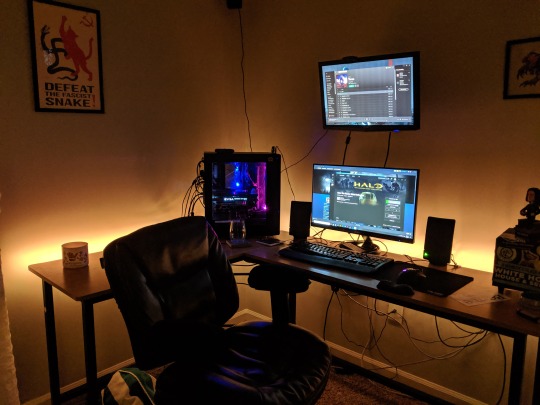
And yet, there’s something I have missed for a long time: gaming on the couch.
Couch gaming is how I grew up. Huddled with friends around a tiny TV and N64, controllers in hand, shouting and laughing. Or leaned back in a chair with a cold soda, savoring every moment of a lengthy Final Fantasy cutscene. An office chair just isn’t the same. It’s rigid and harsh. It says “at attention,” not “relax.” It was the antithesis of my ideal gaming experience.
But after I got my PC, I never bought a console. For one, I couldn’t afford them. In college my money was precious, and my computer – already cobbled together from low-end or used parts – was expensive enough to maintain. The idea of dropping hundreds on a console and proper television was out of the question.
As an adult with more disposable income and now a home of my own – complete with an awesome living room my wife put together – I wanted to have that experience again. But my budget-mindedness and graphical snobbery hadn’t changed, and my PC was upstairs on the other side of the house. What to do?
I wanted couch gaming. And I managed to get it without buying a console or moving my PC to the living room thanks to a hugely underappreciated technology: in-home streaming. Here I’ll share what I’ve learned, discuss setups, and evangelize one of the coolest tech tricks I’ve discovered in homeownership.
What is In-Home Streaming?
You’ve probably heard of Google Stadia, Google’s uh…interesting new streaming game service. The basic idea is that your console isn’t in your living room. Instead, it’s located in a Google datacenter, which streams the game as a video through the internet. It sort of works, with the hiccups you’d expect with streaming a game over the internet: lag, input delay, graphical glitches. It’s like having very, very long HDMI and USB cords.
In-home streaming is basically that, but in your house. With the distance being just a few rooms instead of across state lines, latency becomes much less of an issue. It finally gives PC gamers the one thing we were missing: the couch.
Because it encodes video in real-time, in-home video streaming is a pretty new technology, and it requires certain hardware and software. The two dominant solutions are Steam and Moonlight, and they’re different in important ways.
Steam Remote Play
Steam Remote Play is by far the simplest method. For one, it integrates directly with Steam, so there is no complicated setup. Just install Steam on both devices, boot em up and you’re good to go. It pairs well with Steam’s “Big Picture” interface for a console-like experience.
Steam streaming also runs on just about anything, including very small computers like a Raspberry Pi. This is because it uses H.264 encoding, a standard that has been around for a long time. Just about any computer made since 2008 can play H.264 video, meaning that your old laptop or a $25 PC from Goodwill can be turned into a stream machine. Encoding H.264 on the host machine also has little performance cost.
Where Steam hits a limit is in resolution. Steam can only stream games at the resolution they use on your native monitor. So if your computer monitor is 1080p, you can’t play in 4K when it’s streamed to your TV. You can go lower resolution, which is fine if you’re streaming to some laptop screens.
Steam works with all Xbox controllers, as well as the Dual Shock 4 through DS4Windows.
Moonlight
Moonlight is what I use for in-home streaming. It’s an open-source implementation of NVidia’s “GameStream” technology, originally developed for their Shield devices. My main PC has a GTX 1070, which supports GameStream.
Moonlight has a number of significant advantages over Steam. For me, the most important is its ability to stream in a different resolution than your desktop. So while my desktop monitor is 1080p, I can play games in native 4K on my TV set! For newer games that my PC can’t run at full 4K, I use NVidia’s dynamic super resolution feature to run at 1440p or another resolution, then upscale it to 4K.
GameStream can also encode in HEVC, a cutting-edge video codec that offers superior quality with lower bandwidth. There’s virtually no artifacting, and colors usually look better than with Steam streaming. There is also HDR support. Because HEVC is lower bandwidth, it’s also ideal for wi-fi streaming.
If you’ve been keeping up with all the NVidia mentions, you’ve probably figured out the most significant drawback of Moonlight: hardware exclusivity. GameStream can only encode certain NVidia graphics cards. For instance, the 10-series locks GameStream to the 1050ti or higher, so budget gamers with a 1030 or 1050 are out of luck. Good news is that the receiving PC can run non-nVidia graphics.
GameStream also supports H.264, but for HEVC you need more powerful hardware on the receiving end. So while any old shitty laptop could stream with Steam, it would choke on HEVC.
Moonlight has the same controller support as Steam.
My Setup

When I first built my setup, I set a few standards:
4K, 60 frames per second
Option for “upscaled” 4K similar to the PS4 Pro/XB1X
4K Blu-ray quality HEVC (around 100mbps bitrate)
Quiet
An unobtrusive look, like a home theater appliance
A hard-wired setup for low latency
Less than a week after we moved in, I hard-wired my house for internet. I ran an Ethernet cable all the way from my office, through the garage, under my crawlspace and into my living room. I then crimped the ends (badly) and installed a wall outlet in my office (barely.) If I were to do this now, I’d buy a pre-made 200-300ft CAT6 cable on Amazon and just run that. That said, my cable still works for what I need.
For my streaming PC, I knew that I had to go small form factor. The credenza in my living room didn’t have space for a full-size PC, and the aesthetic of most of those would offend my non-gamer wife. I considered building one, but most SFF hardware is targeted at enthusiasts and so doesn’t come cheap.
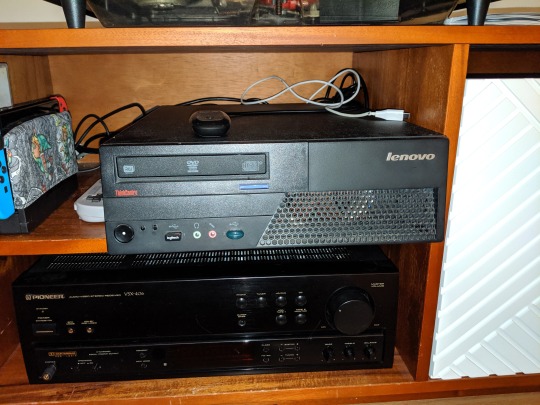
But small form factor PCs have a particular application: offices. When offices dump their old hardware, you can get it for almost nothing. I found just such a deal on reddit’s /r/buildapcsales for a Lenovo ThinkCentre m58p, refurbished from Staples for $20 shipped. It was small, simply designed, and not too flashy. But it is from 2008, and needed a few cheap upgrades:
I swapped out the dual-core E8400 processor for a quad-core Q9400 I had on hand.
I replaced the loud, slow hard drive with a small, cheap ADATA SU635 solid state drive.
For my quiet living room setting, I also replaced the cooling fan with a high-quality Noctua model.

But chief among these upgrades was a graphics card. This PC, being more than a little old, could not play HEVC video without specialized hardware. And it had to be silent, not require much power, and be able to fit inside this small case.
So I turned to the NVidia GT 1030, specifically the MSI low profile silent model. Targeted at home theater PCs and poor gamers, the GT 1030 is not gonna blow anyone’s socks off. But it does 4K, and it does HEVC, and it does all of this over HDMI so it plugs straight into my TV with no issues. One quirk with my model is that the heatsink didn’t fit in my unusual case, so I had to take a hacksaw to it.
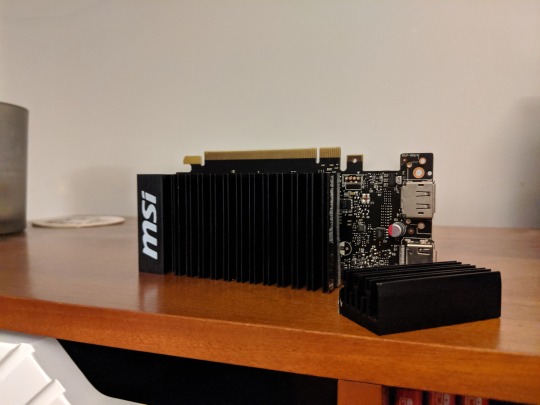
For a truly 1%er experience, I wanted to be able to start my upstairs PC remotely. That way when I want to play, I don’t even have to walk up there. For this I used an Android app called Unified Remote, which allows you to remotely control a computer from a phone. Unified Remote is free, but I bought the premium version with Play Rewards points.
The Value Question
Let’s get the first question out of the way: if a NVidia Shield is $150, why not just buy that? A few reasons:
It has hard-wired ethernet. No matter how good your wifi is, hard-wired is better.
Moonlight’s interface is more flexible than the Shield’s.
This also runs YouTube with a full keyboard remote for easier searches.
I can install a Blu-ray player at some point, if I choose.
I can emulate many games on the living room PC; the GT 1030 is great for that.
It runs party games like Jackbox just fine.
This is more fun.
So let’s run a tally. I’m not counting the hard-wiring, since I needed that for my office computer anyway.
The PC itself: $20
GT 1030: $75
Noctua 92mm fan: $15
Bluetooth receiver: $10
SSD: $15
Q9400: free to me, but you can get one on eBay for like $10
So for $135 – less than a PS4 Pro or Xbox One X – I get 4K couch gaming at higher framerates and higher settings. And for certain games, like Overwatch or Cities: Skylines, I still have a killer keyboard and mouse setup.
You can easily make this cheaper, especially if you use Steam and aim for 1080p instead of 4K. A Raspberry Pi – around $60 with accessories – can do 1080p Steam streaming flawlessly. Most Intel CPUs made after 2011 can decode H.264 without a graphics card, and the 6000 series and higher can even decode HEVC. You could also go for a GT 1030 with a fan, which are usually cheaper.
So How’s It Perform?
In short: great!
I’ve played everything from The Outer Worlds to Slay the Spire to Rocket League on my streaming setup, and they all work perfectly. Sekiro – which requires extremely precise inputs – does suffer a bit from the input lag, but I can’t detect lag with most games. Visual quality is excellent with very little loss in color saturation. You will notice artifacting on grass or leaves when you’re up close, but this is less visible at 1440p or higher.
I would not play competitive games on a streaming setup. The only one I play seriously is Overwatch, and there is definitely a difference in my performance when streaming. Competitive first-person shooters also suck to play on a controller, and a proper couch desk is not an investment I’m prepared to make.
Be prepared to tweak graphical settings if you’re shooting for 4K on most setups, as the video encoding does have a slight performance cost. This is not true for older games; Dark Souls and Dishonored run at a locked 4K and 60fps. For modern games, Forza Horizon 5 runs at 1800p on High, and Resident Evil 2 is smooth as silk at 1440p.
One final tip: if you’re streaming over wi-fi, be prepared to make some compromises. I would stick to 1080p to avoid lag, or do 4K only on HEVC with lower visual quality. Also streaming basically requires 5ghz wifi, so if you have an old router you should probably cut back to 720p.
So that’s in-home streaming! If you’re already a PC gamer, it’s an affordable and easy way to achieve a console-like experience. Feel free to DM me with any questions you have about hardware or software setup.
#tech#gaming#streaming#in-home streaming#remote play#steam#moonlight#nvidia#gamestream#hardware#pc gaming#couch gaming
1 note
·
View note
Video
youtube
New video today! Neon Genesis Evangelion is one hell of a show, but underneath the crazy imagery and symbolism you find an incredibly raw, intimate portrayal of one man’s depression.
TW: suicide, depression
#tw suicide#tw depression#depression#suicide#eva#evangelion#neon genesis evangelion#shinji ikari#shinj#hideaki anno#analysis#video essay#criticism#anime#netflix#dub#philosophy#psychology#hedgehog's dilemma
3 notes
·
View notes
Text
B&C Behind the Scenes: Retro Video Capture On a Budget
People who follow Bread and Circuses know that the blog is dedicated almost entirely to pop culture analysis. But people who are my friends also know that I’m a huge geek for computer hardware. So today, you’ll get you a man who can do both. This is my first behind the scenes feature, where I talk about crazy learning experiences in being a small-time YouTuber. This piece will be very technical, so I don’t blame you for skipping it.

The next project for Bread and Circuses is a full documentary and retrospective on Final Fantasy IX (2000, PlayStation), maybe the most important game in my life and one of the best RPGs ever made. Due to the scope of the video, I’m replaying all the original Final Fantasy games for the original PlayStation to jog my memory and give context for the less researchy parts. I am doing this on original hardware and a tube TV, without resorting to emulation or the re-releases. And I’ll be recording the entire game.
The choice for original hardware came for a few reasons. For one, the newer ports of Final Fantasy games are…mixed, at best. IX’s updated ports feature higher quality models and cutscenes, but the backgrounds are blurry, the new fonts and interface are hideous, and the overall “feel” of the original game is somewhat lost. As inspiration for writing the script, I also want the nostalgic experience of how I first experienced the game.
With that being said, I had a major hurdle to overcome: how do I record 50+ hours of gameplay from a 1995 console?
Step 1: Capture Setup
Most game capture these days is done in two ways: via the device playing the game, or via a capture card. The first method is quite easy on PC: you just fire up Open Broadcaster Suite, use a quick setup guide and you’re good to go. This is what I’ve done for all my videos thus far.
For modern consoles, you can use an HDMI capture card like the Elgato HD60. The cards aren’t exactly cheap, but they’re affordable enough for most streamers and let’s players.
But there’s one problem: both the original PlayStation and PlayStation 2 do not have HDMI output. The early model PS3s can play PS1 games and have native HDMI, but they are rare, expensive, and often break.
While you can buy HDMI adapters for the OG PlayStation, they are spotty in quality and present yet another challenge: such adapters often introduce noticeable input lag. Though FFIX is not a fast-paced game, the lag is still bothersome. They also don’t work with my tube TV, which is critical for my desired creative process.
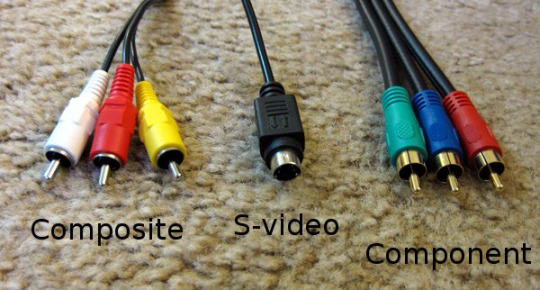
That leaves me with two capture options: composite or S-Video. Composite video is the little yellow guy you used to plug into your tube TV. It looks decent on those, but when captured digitally, the blurriness and drab colors are immediately apparent. It’s for this reason that I purchased S-video cables; without going into boring technical detail, S-Video delivers far richer colors. Because the adapter includes both, I can output to my TV and computer at the same time with no additional equipment!
Speaking of adapters, the PS2 also has the option to output component video, arguably the best analog video available. While capture solutions exist for component video, my tube TV does not accept it. So to use component, I would need a system of complicated adapters and converters to both record on my computer and play on my TV at the same time. It’s too much hassle for not enough results.
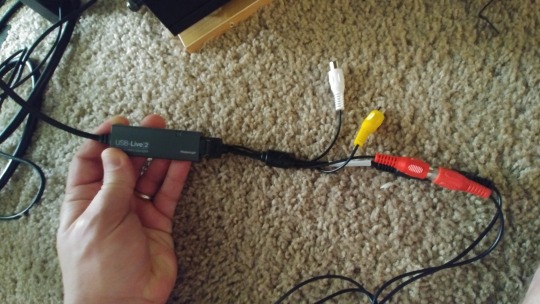
So instead, I did some research and bought this little guy: the Hauppauge USB Live-2. There are many adapters like it, but Hauppauge has brand recognition in this area. This adapter also uses 4:2:2 chroma subsampling, meaning that it sacrifices very little in color depth compared to some cheaper models. It plugs into any USB port.
My tube TV only supports mono sound, which means it only needs one audio cable. I hooked up the left channel (white cable) to my TV, and the right channel (red cable) to my capture card. When outputting FFIX in mono mode, both devices receive the same sounds, and the music doesn’t suffer from missing stereo effects. Perfection.
Step 2: PS1 or PS2?
So as most people know, the PlayStation 2 is backwards compatible with original PlayStation games. The method by which this is done, however, differs based on the model.
Early PS2s have an actual PS1 processor on their motherboard. For the PS2 it’s used for sound and input/output, but when playing a PS1 game this CPU is instead, providing nearly perfect PS1 support. Sony actually did the same thing with the first PS3, but soon realized it was very expensive and scrapped it.
For later models of the PS2 – the slimlines – Sony switched to software emulation to save costs and space. The software emulation works very well, but it is just that: emulation. It is very rare for emulators to be literally perfect replications of the original experience, and Sony’s for the PS2 – called POPS – is not 100% accurate. I also don’t have a slim, so there’s that.
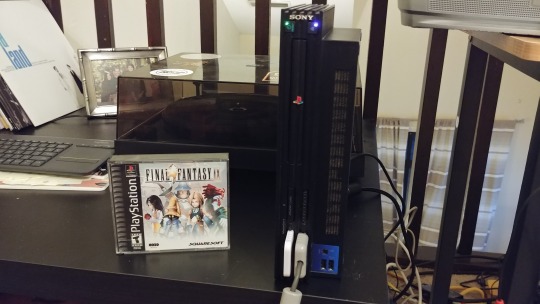
But I’m getting ahead of myself. I first dug out my old PlayStation 1, purchased new in 1998. While the system itself still works shockingly well (despite some skipping during movies), I quickly ran into a problem: the PS1 outputs at 240p. For the uninitiated, video nomenclature like 240p refers to the number of lines in the image along with the scan type. So 240p means there are 240 lines of pixels in the image, and they are updated progressively, meaning all at once.
Older tube TVs can accept 240p input, but output it in interlaced form. This means that the TV quickly updates every other line of the image, rather than the entire image at once. It works pretty good for this type of TV, but on a modern monitor introduces some problems…which I’ll get to in a bit.
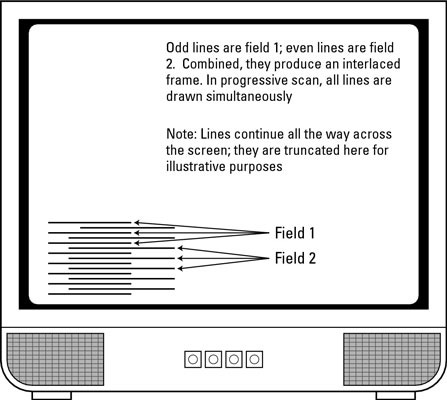
Image from dummies.com. Fitting.
However, this was a problem for me because my new capture card did not accept 240p input. I tried countless times to get it to accept PS1 video, and it just didn’t work. However, I noticed that my PS2 did. That’s because the PS2 outputs by default at 480i, an interlaced mode that my capture card accepted.
So I opted to use my “fat” PS2 instead, which is a SCPH-30001 model, purchased new in 2001. It includes the original PlayStation chip, and – to my enormous surprise – read my original Final Fantasy IX CDs perfectly. Because the PS2 accepts PS1 controllers and PS1 memory cards, it was an almost flawless version of the original PS1 experience. Awesome!
Step 3: Recording
With setup out of the way, I got to the final step of the project: actually recording digital video.
I use Open Broadcaster Software (OBS) for all my video and streaming projects. It’s free, powerful, and pretty fast. My capture device was immediately detected by OBS, but there was one immediate problem.
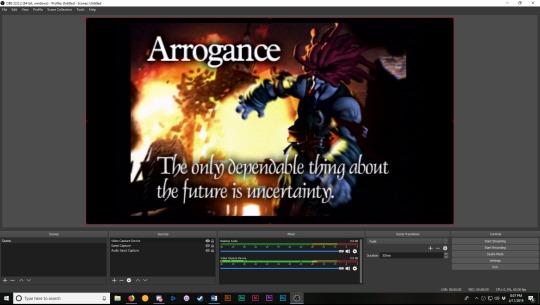
Remember the interlacing I mentioned earlier? When you display interlaced video on a progressive screen – AKA any modern flat-panel monitor – you get a horribly ugly effect where the video seems to be ripping itself apart. This is called combing, and it sucks. Thankfully, OBS supports native deinterlacing, so I was able to fix it right up.
That being said, let’s break down the different parts of recording with OBS:
Resolution: the PS2 outputs in 720x480 pixels, but my videos are at 1920x1080. However, recording at 1080p requires more hardware power, so I get more definition at the expense of less overall quality. I chose instead to record at 720p, which is closer to the PS2’s native resolution and allows me to capture better colors with less blur.
Framerate: this is where things got interesting. I master all of my videos at 60 frames per second. Very, very few PS1/2 games (FFIX included) hit 60fps, because the hardware of the time just wasn’t capable of rendering graphics that fast. However, they do output at a 60 hertz refresh rate, meaning that the image updates 60 times per second even if the console doesn’t actually produce new frames that fast. So if you record at under 60fps, you get noticeable judder in your footage. That being said, 60fps was a requirement.
Encoding: I wanted to get the highest possible quality picture. My computer has a Ryzen 5 1600 processor – a capable mid-range CPU – and is excellent at software video encoding. I used the OBS x264 encoder running at medium quality. Any higher than medium and I started experiencing skipping footage as my CPU went to 100% utilization. I gotta admit, it’s pretty cool hearing my computer fans kick into overdrive as the CPU is pushed to its limits.
Bitrate: I’m recording a lot of footage here, so while I needed high quality, I also have to keep storage limitations in mind. I did some experimenting and decided on a bitrate of 9000kbps, still above YouTube quality while also saving space. This also means that each hour of footage is about 4GB; given that FFIX is about 40 hours long, that means roughly 160GB of footage for the game. Not bad, considering.
Deinterlacing: OBS presents a slew of options for deinterlacing your footage, and the differences can be tough to spot. The only option that gave me zero trouble – no juddering or excessive blur – was Yasif 2x. I also increased the brightness and saturation to make up for some of the analog video deficiencies.
I’ve included sample footage below, along with pictures of my setup. If you’re an aspiring retro YouTuber or streamer, feel free to PM me with any questions. This stuff was kinda intimidating to figure out and I’m happy to help!
Until then, I’ll be in Gaia. Or Terra, once I hit Disc 3.
Jon
Full Setup
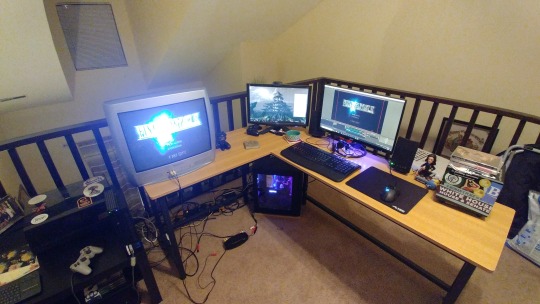
Cable Routing Detail

The TV inputs run through this old AV hub I dug up from my teenage bedroom. This lets me run the cables behind my desk to keep things a bit neater. I say a bit because you can still see the cables back there, but that’s showbiz, baby.
Sample Footage
youtube
#ff9#ffix#final fantasy ix#retro#gaming#ps1#ps2#playstation#capture#hauppauge#video#editing#project#documentary#video essay#criticism#games#2000s
10 notes
·
View notes
Video
youtube
New video is up!
RollerCoaster Tycoon is almost twenty years old, yet it’s still popular, still fun, and still relevant. How has such an old game had such staying power?
#rct#tycoon#roller coaster#rollercoaster#planet coaster#games#video games#gaming#pc gaming#retro#video essay#retrospective#analysis#creative#criticism#sim#simulation#theme parks#amusement parks#youtube
1 note
·
View note
Text
Blog rebrand is live!
Why Is It Good? is now Bread and Circuses. Because with media this good, who needs a revolution?
Next video drops next week. New brand art by @porocora!
0 notes
Text
MAGFest and The Theology of Pop Culture
I have never been an especially religious person.
That’s not to say I haven’t tried. For years as a kid I went to multiple churches, everything from a Quaker meeting house to a very Southern, weep at the altar church. I tried. I prayed every night before bed, I had a “real men love Jesus” shirt, I went on youth group retreats. But I never felt at home at any of those places. When I saw someone speaking in tongues or entranced by music, I couldn’t relate.
Instead, I threw myself into art and pop culture. I read insatiably. I nodded along to punk rock and hip-hop in my Aiwa CD changer. I spent hours glued to standup on Comedy Central and anime on Adult Swim. But most importantly, I played video games.

Video games shaped my childhood – and subsequently the rest of my life – in a way that nothing else really did. Even my family and friends, despite their dearness to me, couldn’t provide the exhilarating sense of newness that video games did. As I grew older my relationship with games fluctuated, and obviously there’s more to life than consuming media. I traveled, I fell in love, I went outdoors, and I made many friends. But video games have always been a comfortable, familiar place to return when the task of living wears me down.
In recent years – thanks to therapy, a supportive non-gamer wife, and like-minded friends – I have reconnected to my childhood love of games on a much deeper level. Part of this is because of an event called MAGFest. After my initial trip there in 2016 to meet internet friends, I successfully evangelized it to my entire friend circle. This year we rolled 11 deep, plus my internet friends and folks I’ve met at MAGFest. None of my other friends ever hear me shut up about it.

So why? Why do I care so much about this? Why do 20,000 other annual attendees care so much?
I should start by explaining what MAGFest is. MAG – short for Music and Gaming – is a 3-day convention outside Washington, DC. Thousands of geeks gather to play games together, listen to electronic and video game music, dress in costumes, listen to experts at panels, and generally rage. Calling it a “convention” is really a disservice, which is why fans and organizers are quick to say “it’s not a con – it’s a festival.” Essentially, MAGFest is a pop culture celebration, equal parts rave, music festival, and cruise without the ship.
Something that separates MAGFest from other cons is its nonstop nature. The schedule begins at noon on the first day and ends at noon on the fourth day, and doesn’t stop. There are no breaks. Also unlike some other cons, MAGFest is concentrated in a single massive hotel venue. You not only attend the party, you sleep and wake there. It is a fully immersive experience.

Speaking of the venue – the Gaylord National Resort and Convention Center – it’s important to understand its size. The Gaylord is a 16-floor hotel with thousands of rooms, four warehouse-sized exposition halls, a rooftop nightclub, and an open-air atrium with one side entirely made of glass. Outside this glass façade you see the lights of DC across the Potomac. There are probably some European countries smaller than the Gaylord.
The Gaylord also sits on one side of National Harbor, a master-planned resort town. The restaurants and shops there are very much of the touristy variety, and many of them are overpriced and underwhelming. But when MAGFest takes over and the streets are filled with cosplayers and music, the phony veneer seems to slip away.
The Gaylord and National Harbor have no real identity of their own; they are a blank canvas on which to project whatever event they host. And when MAGFest comes to town, they become a sort of geek city. A futuristic, borderline utopian center of chaos, partying, music, and general celebration. It feels like another planet, and during the almost annual blizzards it looks like one too. The Gaylord is effectively a giant spaceship piloted by a bunch of nerds, hosting a sleepover with 20,000 of your friends.
And the sheer amount of things to do with those friends is overwhelming, especially for first-timers. There’s a full arcade with both popular and rare games to play, all included in admission. There’s a room full of every gaming console imaginable with 24/7 attendance and both pick-up and organized tournaments. A marketplace full of talented artists and experienced merchants. Concerts running all day, both with professional musicians and spontaneous jammers in the halls. An entire annex dedicated to tabletop games, with a two-room library of them to rent as you please.
youtube
But aside from all the events, simply being at MAGFest is an experience. Much of my memories there are flashes, moments. Sitting on a balcony overlooking crowds and neon lights, having heart-to-hearts at 3am. Sipping whiskey and wandering through the halls as strange music plays and cosplayers pose for photos. Dancing at concerts until it hurts. Running a D&D game for my friends and hearing them shout with joy as they conquer my challenges. Connecting with costumed strangers in the glass elevators. Chatting with musicians after their sets. Meeting hundreds of other people who just get it, who understand why church was so weird and my TV set felt like such a safe place.
When I go to MAGFest, I don’t feel pressured to be anyone but myself. There are no obscure interests to hide. There’s no phony workplace air of professionalism. There is none of the responsibility or burden of being an adult with goals and plans and a schedule.
When I’m at MAGFest, I’m free.
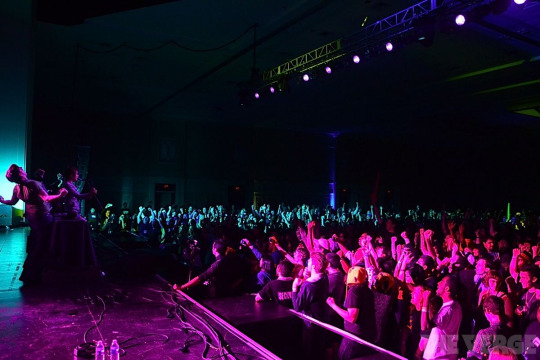
The essence of being a geek is having an attachment to culture. Not just any culture, but culture that doesn’t intersect with society in the way that organized religion or even family units do. Because of this separation between geek culture and the societal hierarchy, so much of what we consume is based on fantasy. Escapism. Wish fulfillment.
If geek culture is based on this sense of leaving the world – of fleeing – MAGFest is something like a dream. A three-day dream of color, music and light. A haven where those dreams are suddenly made real, where the imagination that we wistfully seek in cubicles and traffic jams is tangible. It’s an escape, but more than that it’s a temporary reality. The hangover from MAGFest is certainly due to hard partying, but it’s also because of re-entering the gray, predictable, formulaic reality of living.
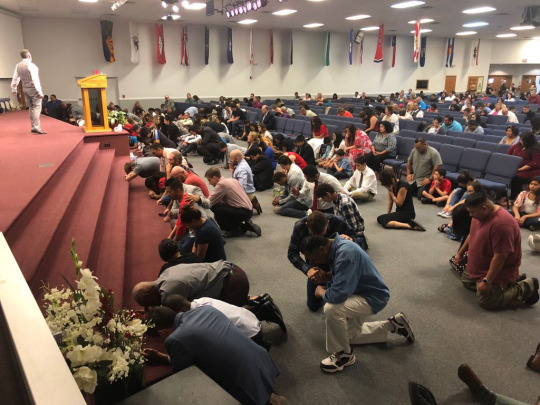
So for the guy speaking in tongues at church who I snickered at, for the youth pastor who glared at me for not crying at the altar, for the kids in high school who called me “baby killer” after I renounced religion…you know what? I get it now. That was your MAGFest. That hour every Sunday felt like a new world to you. You constructed it with your friends and family and let your heart go raw with love and passion. You found your new reality in those places.
But my reality of choice? It’s MAGFest. It’s a 3-day vacation, it’s a place for memories with friends, it’s a shit ton of booze and video games.
But most importantly, it’s home.
#magfest#magfest 2019#convention#festival#music#gaming#cons#con#cosplay#geek culture#nerd#national harbor#gaylord
5 notes
·
View notes
Text
Trauma! at the Disco: “This is Gospel” and the Ghosts of Mental Illness
Like many people my age, I have a soft spot for mid-00s rock music. Being a teenage music listener in that time was very exciting; MySpace was thriving, and it opened up previously obscure genres. Before then, I doubt most people my age had never heard emo, or horrorcore, or post-hardcore. But by the time 2005 hit, we were all awash in black clothing and crunchy guitar riffs and lyrics about dying.
We loved this music for its emotional rawness, despite its clumsiness. If you listen to, say, Hawthorne Heights in 2018, lyrics like “cut my wrists and black my eyes” are cringey enough to be physically painful. But for a teenager of the time – even one not actually self-harming – there was nothing more cathartic than these over-the-top one liners.
youtube
Still, the emotional truth was there, underneath layers of embarrassment. We can still feel it today, as one of those bands – Panic! at the Disco – is still capable of writing an emotional powerhouse of a song. That song in question is called “This is Gospel,” and for disaffected millennials it may be more cathartic than ever.
Note: this essay addresses psychological trauma, alcoholism, and substance abuse. Read with care if those things may upset you or hamper your path to recovery.
As we’ve all grown up, very few bands from the emo era have had real staying power. The ones that do embrace a theatrical edge that stretches beyond their genre. For instance, My Chemical Romance took teenage angst and made it into a Queen-esque rock opera called The Black Parade, and Skrillex parlayed his role in From First to Last into the equally angry, frenetic dubstep phenomenon.
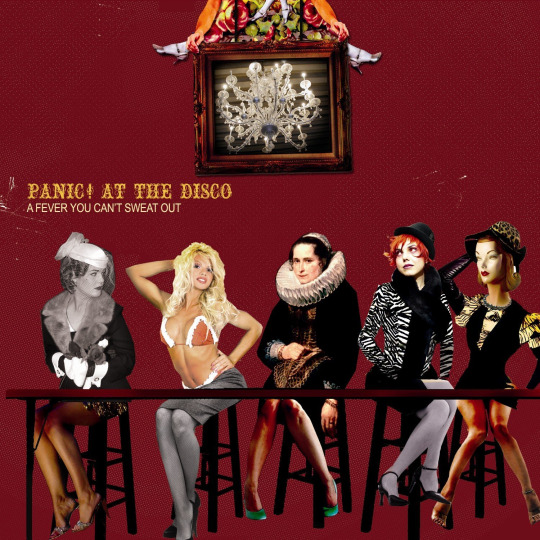
This makes Panic! At the Disco especially interesting. Even on release of their debut, A Fever You Can’t Sweat Out, these guys were obviously something different. There was no screaming. The music was tinged with drum machines and accordions. Singer Brendon Urie’s voice was bright, clear, and almost operatic. The lyrics were literary – freshman year “I just read Fight Club” literary, sure, but still literary. Yet underneath these new elements beat the same teenage energy, where casual hookups were epic romances and someone not answering your text was the ultimate betrayal.
Though all of the original band members except Urie have since left, Panic! are still putting out albums in 2018. Their newest, Pray for the Wicked, sounds almost nothing like their debut. Given the band’s tumultuous history and shifting lineup, such a shakeup in their sound is understandable. Most of their original fans are probably as lukewarm on their current catalog as I am, but they’ve found their lane and stuck to it.
One element of the original sound, however, still persists: Brendon Urie can sing his ass off.
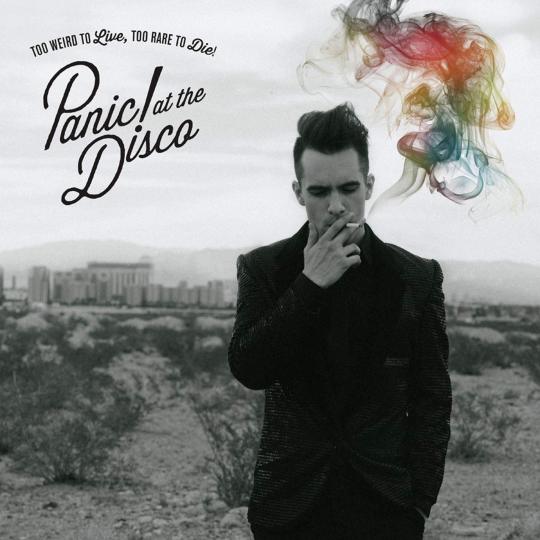
Nowhere is this more apparent than in the piano version of “This is Gospel,” from their 2013 album Too Weird to Live, Too Rare to Die. The album version has the bombastic, electronic arena rock sound other bands from their era have (unfortunately) gravitated to; it’s rather generic, and the over-the-top production and poor mastering drown out Brendon’s voice.
But the band also released a gorgeous, stripped-down piano version, and it’s that version that really matters.
I mentioned earlier that Panic! has a bit of a tumultuous history. They started making music in their late teens, and when “I Write Sins Not Tragedies” launched their careers, they were too young to handle the fame. That had the most pronounced effect on drummer Spencer Smith, who eventually left the band due to his persistent drug and alcohol problems. Being a rock star is hard, but being a rock star at 19 sounds awful.
Per his own annotations on Genius, Brendan Urie wrote “This is Gospel” about Spencer’s addiction. It’s obvious from the lyrics, which are equal parts rage and a desperate plea. He leads off with this biblical verse:
This is gospel, for the fallen ones
Locked away in permanent slumber
Assembling their philosophies
From pieces of broken memories
From there, the song builds to a soaring chorus with the refrain of “if you love me, let me go.” Brendon’s voice is at once powerful and delicate, and his lyrics – comparing words to knives, expressing a “fear of falling apart” – convey a suffering but authentic friendship. Brendon’s anger is not at Spencer, but instead at Spencer’s addiction, a disease and all the awful things that caused it to fester.

Backing up to the opening verse, that biblical theme runs throughout the song. For Brendon, his friend’s addiction feels religious. It doesn’t always make sense, and his friend doesn’t always believe in it, but it still shapes his life. If you grow up religious, you can renounce it when you’re older…but the memories still persist.
Addiction and trauma can go hand-in-hand, but even separately they are almost mirror images. As an addict might drink til blackout night after night, a traumatized person relives their troubled past by acting out, or self-harming, or self-loathing. It’s a cycle you get trapped in, and most of it is tied to something that, far in the past, really messed you up. It becomes a set of rules you live by. A gospel.
There is a concept in psychology called the "repetition compulsion." It's the idea that most human behavior is driven by a need to relive past experiences, even if those past experiences were harmful. It's why people can repeatedly date terrible partners, why addicts can relapse, and why parents who abuse their kids were often abused themselves. Often, these people know what they're doing is wrong. They know they are hurting themselves and others. They fully understand that they should not do these things.
And yet, there is a powerful, emotional tug binding them to their trauma, one they may never overcome. It’s a past assembled “from pieces of broken memories.”
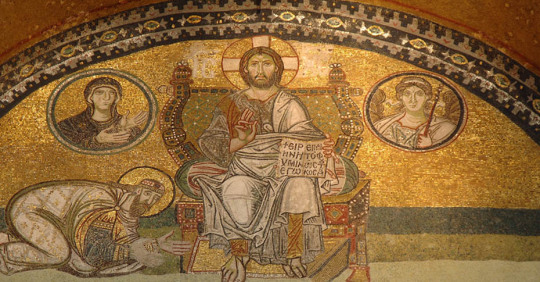
In this way, trauma is scripture, both functionally and figuratively. Like the Bible or Qur'an, it's a way of dealing with huge questions. Why am I here? Why do people do bad things? Why does my heart hurt so much? Trauma provides the earliest and most convenient answers, with the unfortunate caveat that those answers usually hurt you.
Brendon Urie was raised in the Mormon church, and left when he was 17. As a pansexual, slim suit-wearing singer in a rock band, he's pretty far from his LDS roots. Perhaps this is why his performance here - and his lyrics - are so heartfelt. Coming to terms with your trauma often feels like renouncing a religion, complete with all the burned bridges, strained family relationships, and sense of being eternally lost.
The aching truth of surviving trauma is that it follows you forever. It gives you rules for how you think, how you maintain relationships, how you view yourself. Because of those rules, you think it gives you stability. Sometimes that stability feels like love, in the same way that a good partner makes you feel safe. It's precious predictability. But if your trauma truly loved you, then - as Brendon sings - it would let you go. Admitting that is both important and unimaginably painful.
youtube
Another of my favorite vocalists, Frank Ocean, has a similarly beautiful ballad called "Bad Religion." In it, he croons "if it brings me to my knees, it's a bad religion." Trauma is a bad religion, and worse than any of the others we create, it is often one we cannot choose. Leaving it behind feels like betraying an old friend. It’s a "fear of falling apart."
If trauma is the holy book of our lives, we can only move forward by burning it. Build a pyre with your trauma and stoke the flames until the heat frightens you. Let it all burn to the ground. Use the ashes as war paint, and maybe listen to Brendon’s advice:
Don't try to sleep through the end of the world
And bury me alive
Cause I won’t give up without a fight
#panic at the disco#brendon urie#this is gospel#too weird to live too rare to die#music#emo#2000s#2000s music#criticism#mental health#addiction#trauma#mental illness#my chemical romance#frank ocean#spencer smith#essay#why is it good#tw self harm
3 notes
·
View notes
Video
youtube
Overwatch is a fun game, but it’s also a reminder of what happens when we work together.
New video essay is up!
#overwatch#blizzcon#blizzard#video essay#criticism#games#gaming#pc#ashe#tracer#widowmaker#bastion#analysis#video games#omnic crisis#overwatch league
4 notes
·
View notes
Video
youtube
I am extremely happy to announce the first “Why Is It Good?” video essay on VA-11 Hall-A: Cyberpunk Bartending Action. It is both anime trash and a deeply moving, political game about the struggles of working class people.
#VA11-HALL-A#Valhalla#sukeban#glitch city#video essay#video games#pc gaming#indie#criticism#games#visual novel#anime#garoad#politics#pop culture#analysis
9 notes
·
View notes
Text
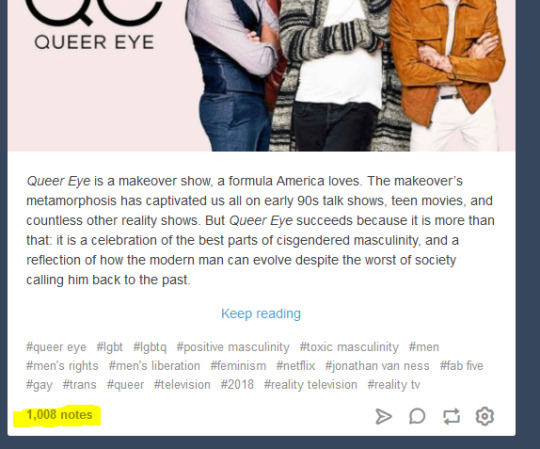
1,000 notes! Thank you, thank you, thank you!
Also, this is probably a good time to announce that I’m working on my first WIIG video essay, coming sometime in early September.
Thanks for your readership and support.
Jon
0 notes
Note
you should branch out to youtube!!
Thanks! I have thought about it. I have video editing experience and do okay on camera. It just takes soooo much more work than writing.
1 note
·
View note
Text
Hello reblogs, likes and new follows!
Seems like that Queer Eye post is doing pretty well, my biggest success so far on this blog. Hope you enjoy my work and do feel free to share your comments and counterpoints.
Also feel free to follow me on Twitter @tybasedjon!
3 notes
·
View notes
Text
Why Is It Good? Queer Eye (2018)
Two things have shaped my life most in the past five years: meeting and marrying my wife, and therapy.

Chelsea came first. It was an OkCupid date, then several more regular dates. Neither of us was very ready for all the relationship stuff that came after that. But I realized that all the women I’d known before, all their emotional labor and patience and (to my credit) occasional misbehavior had prepared me for her. I knew this was my time to get it right.
A big part of getting it right was to go to therapy, and it was partially because of Chelsea that I went. Therapy has transformed my life. Therapy also sucks.
Therapy sucks because it requires vulnerability. It requires embracing emotions you usually run from, discomfort you attempt to control, and change you struggle to implement. It is great self-care precisely because of how much it sucks. It is a cleansing, a renewal, a pause button on your life that allows you to reassess and have a tiny starting-over.
For men, I think therapy is a particular challenge. Even for men like me: indoors kids, the last picked for soccer, guys who argue about Smash Bros. mains instead of running backs. Because a common thread tying all forms of masculinity together is a reluctance to admit not even failure, but a need to improve. If you need to improve, you’re broken, and if you’re broken, then suck it up. For less surly men, there is certainly less chest-beating, but there is equal or perhaps more laziness.
So therapy, despite the tender wounds that result, is the opposite of that. It is a declaration that you deserve fixing. It means that underneath the marks life leaves on you is a person that is beautiful, valuable, and noble.
As a result of therapy, I take better care of myself. I exercise. I eat better, despite a persistent belly. I dress better, despite that same belly. I drink less and hydrate more. I’m a happier version of the same dude that walked into my therapist’s office five years ago.
You could even say I got a makeover, of sorts.
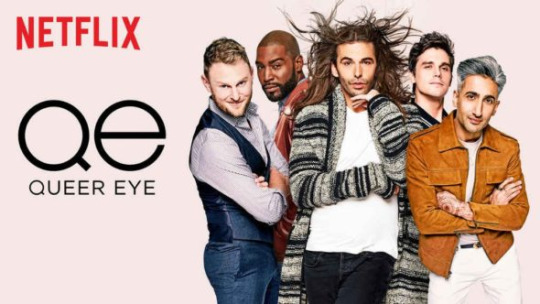
Queer Eye is a makeover show, a formula America loves. The makeover’s metamorphosis has captivated us all on early 90s talk shows, teen movies, and countless other reality shows. But Queer Eye succeeds because it is more than that: it is a celebration of the best parts of cisgendered masculinity, and a reflection of how the modern man can evolve despite the worst of society calling him back to the past.
If you haven’t watched it, Queer Eye is a Netflix show with a simple concept: a group of five LGBTQ men (the “Fab Five”) give a straight (or straightish) guy a makeover. Each man specializes in a particular area, be it fashion, grooming, or culture. The series originally aired on Bravo in the mid-2000s.
Obviously things have changed over fifteen years, so such a show is not as brave as it was during the Bush era. Likewise, simply being gay is no longer the mark of progressive masculinity that it once was. Instead, Queer Eye succeeds in a more gay-friendly climate because each of the Fab Five is truly passionate. Antoni’s face lights up talking about food; Karamo’s infectious smile and friendly eyes suggest a person who really cares about the men he speaks to; Jonathan’s relentless enthusiasm and scientific knowledge of hair are equal parts endearing and impressive. It’s a reliance on technical expertise rather than tokenism, not so different from the experts Rick Harrison leans on in Pawn Stars.
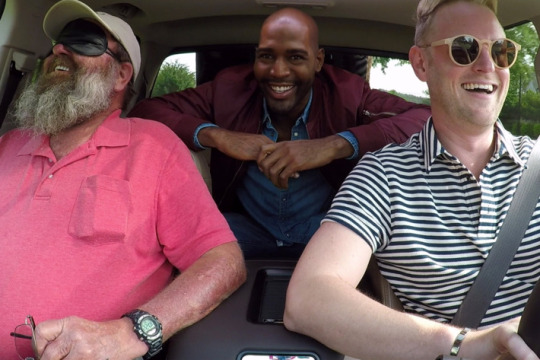
So why, then, must they be gay? Not a bad question. But gay men, simply by existing, have had to do more self-discovery than most straight men. Questioning your sexuality requires the same sort of introspection and triumph over doubt as therapy. So while straight men can absolutely improve each other, the gay men who helm Queer Eye can give it a particularly powerful jumpstart. They even do great work on other queer men, with a closeted gay man and trans man represented.
Toxic masculinity is probably the most misunderstood phrase in our new lexicon of social justice terminology. People read it at face value and assume it means that all masculinity is bad. At best, this turns people off; at worst, it convinces them that there’s some gay Marxist conspiracy to undermine masculinity.

But of course traditional masculinity isn’t toxic. It’s great, when applied correctly. Providing for others, strength, bravery, and loyalty are all noble aspects of your grandfather’s masculinity. What Queer Eye shows is that you are not beholden to them, that you can be more than that. This is evidenced by how the Fab Five use a man’s personality as a foundation for his makeover, rather than ask him to change it.
For instance, look at everyone’s favorite episode from Season 1, “You Can’t Fix Ugly.” Its subject is a stereotypically masculine man who loves cars and redneck simplicity. The Fab Five produce a man who still attends car shows, still loves simple, spicy food, and still wears his distinctive beard. Or Season 2’s ”The Handyman Can” about an aging hippie with a penchant for art, but not for personal grooming. He is encouraged to pursue a love interest, refine his skills and present himself confidently to the world.
This kind of growth – improving yourself, rather than changing yourself – is extremely healthy, and it’s something that men desperately need.
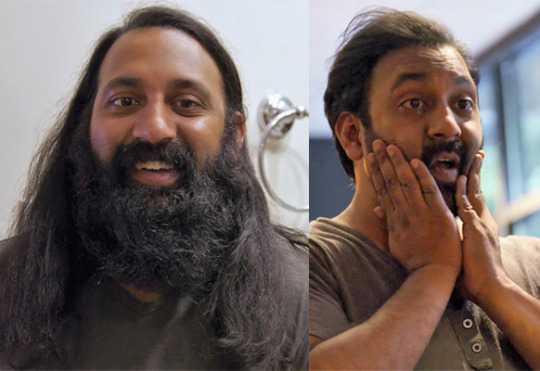
Men are in danger. Not from feminists, not from the law, but from ourselves.
We are beset by patriarchal expectations of who we are, and shamed when we fail to meet them. Shy men are mocked and ridiculed, effeminate men are derided as sissies, and unattractive men are shamed…often by other men. It creates a cycle of shame, aggression, and low self-esteem. At best, such conditions result in mediocre and unhappy men. At their worst, they fester into sexual misbehavior, domestic violence, and even mass shootings.
I’m not naïve enough to suggest that a show like Queer Eye can singlehandedly solve these problems. But the role of popular culture in influencing us cannot be understated. It normalizes new ideas and inspires through its consumption.
Given that truth, we need more shows like Queer Eye. Not even makeover shows, necessarily: we need shows that display well-adjusted, happy, and healthy men. Such images can do a lot to counter the angry, selfish role models we are often expected to look up to. We deserve better.
Queer Eye Seasons 1 and 2 are currently streaming on Netflix.
#queer eye#lgbt#lgbtq#positive masculinity#toxic masculinity#men#men's rights#men's liberation#feminism#netflix#jonathan van ness#fab five#gay#trans#queer#television#2018#reality television#reality tv
1K notes
·
View notes
Text
[Guest] Why is Pitbull Good?
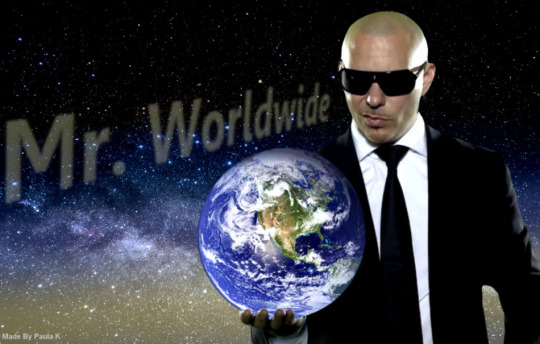
Today I am pleased to publish the blog’s first guest entry. It comes from Daniel Dockery, an editor for Cracked, writer for SyFy Wire, comedian, and the world’s leading scholar on Pitbull (that’s only kind of a joke.)
My wife recently got me into the Who? Weekly podcast, a show discussing reality show stars, one hit wonders, and other almost-celebrities on the fringes of fame. These people are called whos, whereas people like Tom Hanks are called “thems.”
Rapper Pitbull exists at the precise intersection between a who and a them, a pop star everyone knows but also seems to know nothing about. His music, though shallow, is a reflection of that personality...and Daniel has thought a lot about it. Without further ado...
One of the most curious times in college is the Freshman year pop culture purge. Your taste in movies, TV, music, video games, and books, a taste that you’ve been developing for the first eighteen years of your life, is suddenly judged and dissected by your new university peers.
Your favorite rap song was 50 Cent’s “Disco Inferno?”
“IT DOES NOT PASS” says the gods of Olympus aka the Dudes in your Dorm. “YOUR PENANCE SHALL BE 50 REPLAYS OF THIS SAME GODDAMN AESOP ROCK ALBUM, AND ALSO A QUICK SCANNING OF THE JEDI MIND TRICK’S WIKIPEDIA PAGE.”
Your favorite film was Pulp Fiction?
“NO LONGER,” says the gods. “THOUGH YOU SHALL STILL BEAR THE PULP FICTION POSTER ON YOUR WALL AS YOUR SCARLET LETTER. INSTEAD, YOU WILL NOW WATCH THERE WILL BE BLOOD AND HAVE LIGHT DISCUSSIONS ABOUT ITS THEMES WITH THE OTHER DUDES IN THAT ONE FILM STUDIES COURSE YOU WILL TAKE.”
Your favorite book was Of Mice and Men?
“SO IT SHALL STAY,” says the gods. “BUT BE WARNED. ONE DAY, SOMEONE WILL HAND YOU A COPY OF INFINITE JEST, AND WHEN THAT DAY COMES, YOU MUST BE PREPARED TO ACCEPT SUCH A HALLOWED GIFT.”
And so, shedding your childish things, you enter the rest of college renewed. You’re now a person with “good taste in things,” which is the third greatest thing that you can have in college (The first is an ID, and the second is an uncle that owns a cabin.) And you take this “good taste” out of college and into the world. Though you may not discover as many “good things” due to having a more busy adult life, at least you will now be equipped to better judge between what is a “good thing” and what is a “bad thing.”
It was during this time that Pitbull hit me.

Pitbull, for those without radios or access to sports bars, is an American rapper born to Cuban parents. His hits, like “Give Me Everything,” “Don’t Stop The Party,” and “Fireball,” have become enormously popular, though he is probably just as well known for featuring on other people’s songs, signifying his inclusion in them with a “Mr. Worldwide!” and a “YEEEEEAAAAHHHHOOOOOOOOO.” To his detractors, these probably sound like the two trumpets of the musical apocalypse.
But I adore him.
Now, admittedly, Pitbull isn’t the best lyricist. He can spit a very, very competent verse from time to time, like in “Triumph”…
youtube
But most of his songs are in the typical “Let’s get hammered and have some fun!” genre. And while his beats and production techniques have become more varied since around 2014…
…a lot of his tracks still follow that David Guetta pattern of “woop woop, woop WOOP woop, woop WOOP WOOP, WOOP WOOP WOOP” synth and noise lasers.
Also, his onstage persona of rapper/motivational speaker/geographer can be a turn off for some. I’ve seen him live twice (once at Madison Square Garden, and once at a music festival in south Florida) and between nearly every infectious, dance-ready song, he enters into a segment where he vaguely implores us to be better people and to also love the 305 (or whatever area code that you’re from.) It’s like a vodka-soaked inauguration speech, and in the middle of it, I’ve seen people in the audience go from “Yeah! This is different!” to “Can we get back to the grinding now?”
I obviously love Pitbull for all of these things, but they’re not what makes Pitbull good. No, what makes Pitbull good is his many, many quirks. Because while most consider him to be the Nickelback of rap music (with Flo Rida serving as the Creed of rap music, though that comparison is much more accurate), the world presented in Pitbull’s music is an insane one. For example, Pitbull’s tendency to constantly go by his alias, the secret agent “Armando Bond”, in various music videos about getting laid in hotels (He also goes by “Agent A” in his song “Back In Time,” a song created to promote Men in Black III. He works himself into the film in the video, nodding at Will Smith in a restaurant for no reason at all, and then leaving with his lady friend to go stand around in the MIB headquarters.)
youtube
Or maybe one of his catchphrases “But forget about that,” which he employs whenever the verse that he’s just spit is not in line with the chorus in the slightest. If the song is called “LET’S SEX IN THE POOL,” Pitbull would spend an entire verse talking about how kids shouldn’t use drugs, and then quip “BUT FORGET ABOUT THAT. YOU KNOW THE RULES/LET’S SEX IN THE POOL. DALE’.”
Or Pitbull’s bizarre relationship with jokes, a thing that he’s still trying to master the basics of. In “Come and Go,” he croons “Now you heard about me/And I aint gotta say much/I aint talking about cars/It’s automatic, I’ll pop yo’ clutch.” Normally, you’d say that thing about the clutch, and THEN reveal that you aren’t talking about cars. But Pitbull states that he’s not talking about cars, apropos of nothing, and then goes into his sexual metaphor.
Or his penchant for referencing the most miniscule aspects of famous pieces of pop culture. During his verse in “Can’t Believe It,” a song about huge asses and there is no second subject, Pitbull says “Call me Michael Jackson (HEEE HEEEEEE,) ‘cause I love to play with monkeys.” He’s like an encyclopedia in that way, reminding you that “Oh yeah, Michael Jackson did go through a long ‘I have a pet monkey’ phase.” Or in “Better On Me,” where he states “My name aint Max, but I always got headroom/ G-g-g-get it, g-g-g-g-g-get it?” First of all, who in Pitbull’s primary fanbases remembers Max Headroom, much less the fact that he stuttered?
Or the fact that, despite being very prolific on Facebook, Twitter and Instagram, Pitbull HATES social media. I’m serious. He says so in multiple songs. That dude LOATHES apps of any kind.
youtube
She Instagram? I’m off that. Communism? I’m off that.
Pitbull is good because Pitbull is rewarding. He’s like an auteur filmmaker that keeps using the same cast and the same themes. He is hardly deep, but for those willing to pause the song and say “Wait, what did he just say?”, his discography is a journey. His stage shows are filled with scantily clad dancing girls, but it also opens with Tony Robbins listing what is basically Pitbull’s resume over a Powerpoint presentation. He’ll sing a dirty song about getting to third base with strangers, and then the next song will be an anthem to single moms around the world.
The biggest problem with dividing things between “good” or “bad” taste is that it rids us of our curiosity. The good things become worthy of your obsession and your understanding while the bad things are just bad. And when something, whether it be a movie or a musician or an Arby’s roast beef sandwich, becomes known as an objectively bad, all discussion ceases about it. Because no matter how much you try to convince people to check it out and dig deeper and maybe get curly fries to compliment it, they refuse. Because it’s “bad.” And they have “good” taste.
Pitbull is good because he proves that having “good taste” in everything isn’t that fun. Sometimes, you just have to drink some tequila and jam to some Pitbull, and the people that find him uninteresting just haven’t been paying attention.
Further Reading
You can read more of Daniel’s pop culture takes on his Twitter.
You can hear Daniel and his collaborator Jason Edwards’ account of their first Pitbull concert on their podcast here.
#pitbull#rap#hip hop#miami#mr. 305#mr. worldwide#kesha#pop music#criticism#pop culture#music#cuban american
0 notes
Photo

Avicii passed today. Some thoughts on his music and EDM in general:
Most of my readers probably don’t know that I spent the majority of 2012 and 2013 in the throes of serious (at one point suicidal) depression. It sucked ass, to put it mildly.
One of the major things that helped me climb out of this place was running, which paired nicely with therapy and Paxil. I ran way more than I ever had, and way more than I do now, hitting just about every park around Greensboro on a regular basis.
I kept a ever-changing Spotify EDM playlist for these runs. EDM was great for them because it was music I didn't have to think much about, and the cheesy choruses and fast-paced beats helped keep me moving. I remember very vividly when I finished my first 5k, Avicii's "Fade Into Darkness" was playing. As soon as my phone's tracker hit 3.2 I collapsed onto the ground. I was exhausted, but it was one of the happiest moments I'd had in those two years, and it was set to this guy's music.
Avicii's music is never something I've evaluated critically. His albums never did anything for me. But it speaks to the power of art that it often transcends criticism of itself, becoming far greater than the sum of its parts through circumstance and the power of association. Our guilty pleasures may not succeed artistically, but they succeed in something that is arguably far more important and just as powerful.
RIP Avicii. Thanks for giving me exactly the soundtrack I needed.
1 note
·
View note
Text
Why is “Getaway Car” (Taylor Swift, 2017) a good song?
I typically prefer that this blog be dedicated to stuff I wholeheartedly love, and that is not the exception today. However – like finding a ruby in a mound of earth and rubble – in order to love today, I must hate first.
Albums that disappoint will test any fan’s patience. Two of my favorite acts, Drake and Gorillaz, put out some real letdowns recently (Views and Humanz), albums made even more frustrating by their frequent moments of brilliance. Those moments, rather than satiate my hunger, instead only left me wanting more. I wanted so much for those projects to capitalize on those shards of potential, rather than build mediocre shrines around them with signs saying “look at this.”
Arguably the most disappointing album of 2017 is Taylor Swift’s Reputation. While I recognize her catalog’s unevenness, I will never deny the catchiness, relatability, and gut punch romance of a great Taylor Swift song. I’d even call myself a fan.
youtube
However, Reputation also had one of my favorite tracks of 2017: a retro-inspired, soaring pop masterpiece called “Getaway Car.” Today I’d like to explore that duality.
So before we answer “why is it good?” we have to ask another question: why was Reputation bad?
On her last album 1989, Taylor Swift ditched her country heritage completely – whatever tattered scraps she clung to on Red – and went full electronic pop. It was generally a success. Like most of her records there was undeniable filler, but the singles and a few hidden gems like “New Romantics” proved that Taylor’s songwriting prowess spanned multiple genres. Lyrically, 1989 also addressed a certain millennial zeitgeist of whirlwind relationships, new places, and uncertainty about the future. This lyrical consistency is best represented in “New Romantics:”
youtube
We're all bored, we're all so tired of everything
We wait for trains that just aren't coming
We show off our different scarlet letters
Trust me, mine is better
We're so young, but we're on the road to ruin
We play dumb but we know exactly what we're doing
This kind of subject matter represented significant growth for Swift, who had made a name for herself on breakup songs and heartbreak ballads about star-crossed lovers. But even more than the content itself, how she handled the content was what mattered. 1989 portrays its subjects as victims of circumstance, well-meaning people who can never quite overcome their bad habits or worst impulses. They’re dreamers.
That kind of wistful version of millennial adulthood is faithful to Taylor’s less mature roots. It’s from the same girl who wrote ”Love Story” and “You Belong With Me,” but told with more wisdom. It felt like a coming-of-age story made manifest.
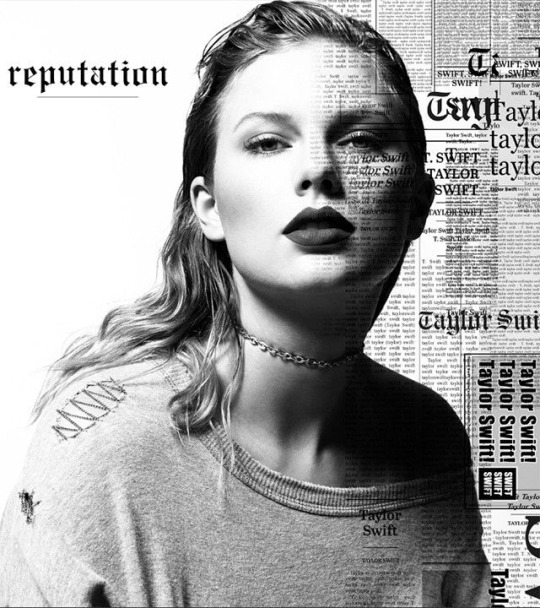
So when Reputation was announced, expectations were high. Taylor had also recently suffered a bit of a brand crisis: she was caught snaking around with Kanye, pulling weird relationship shenanigans with several boyfriends, and other celebrity drama that is decidedly not like “Love Story.” Given those circumstances and the mature songwriting from 1989, I was hoping for a seriously introspective record that would analyze fame and ego from the young-at-heart Taylor Swift’s perspective.
The first single, “Look What You Made Me Do,” is emblematic of what happened instead. The song’s ugly, dated dubstep production collided with ridiculous lyrics and a bizarre “I’m Too Sexy” interpolation. But the lyrics – normally Taylor’s strong suit – were the worst part, a self-obsessed mess of half-truths, hyperbole and victimization. Pretty fitting for 2017, but not a great piece of music.
It is interesting to see such themes manifest in Taylor when they have also manifested in her mortal enemy: Kanye West. Indeed, many people compared “LWYMMD” to a sort of Yeezus-lite on their first listen, mainly because of the distorted production and hedonistic, self-obsessed lyrics.
youtube
Unfortunately for Taylor, though Kanye is indeed an asshole, he’s also much better at this particular type of writing. Yeezus and its predecessor, My Beautiful Dark Twisted Fantasy, observe fame from all of its angles, and stick an inescapable sadness and sense of self-destruction under their boasts and brags. On his latest Life of Pablo, Kanye displays a self-awareness that often escapes Taylor on the song “FML:”
God, I'm willing
To make this my mission
Give up the women
Before I lose half of what I own
I been thinking
About my vision
Pour out my feelings
Revealing the layers to my soul
So while Reputation was indeed store-brand Diet Yeezus in all the worst ways, it did have a few excellent tracks. One of those is “Getaway Car,” a song that embodies everything Reputation should have been.
The song’s production builds on the 80s motifs of 1989, its huge percussion and neon synths bathing the melody in a bright glow. The steady background drums imply a sense of urgency and danger, and the gorgeous, piano-laced bridge (always a talent of Taylor’s) crescendos to what feels like the credit roll of a great action movie. It borrows more than a little from Carly Rae Jepsen, Chvrches, and Lorde (likely not a coincidence, as Jack Antonoff produced both this song and Lorde’s Melodrama.) Compared to the often half-assed hip-hop or electro production on the rest of the record, “Getaway Car” is beautiful and lush in the same fashion as Taylor’s best acoustic songs.
Lyrically it’s pretty similar to a lot of Swift classics: two star-crossed lovers are a Bonnie and Clyde style team. Their crime of choice is fleeing a relationship that Taylor knew she had to leave, two criminals escaping in the night. But at the end of the song, Taylor also leaves her new partner, asking him to “think about the first place you ever saw me: in a getaway car.” It plays with the themes of fate and impossible odds, themes she echoed earlier in her career on “Red,” “Stay Beautiful,” “Style,” and “Love Story.”
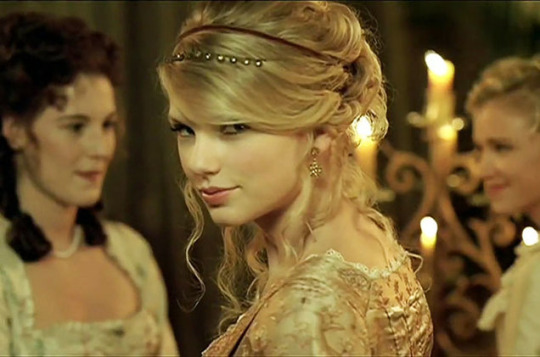
What it does differently from those songs is portray Taylor not as a victim of circumstance, but rather a criminal. She is shown as a heartbreaker, perhaps one worn down by the rigors of romance and fame. She comes across as someone desperate to keep her head above water. It merges the deterministic themes of her early work with a newfound introspection, self-awareness, and edge. Most importantly, it does so without resorting to the rest of the album’s half-assed attempts at edginess: the unbearably mean “This is Why We Can’t Have Nice Things,” or the very PG-13 “I Did Something Bad.”
“Getaway Car” is a song that’s both grown up and fun. Rather than the clumsy, unrealized vision of Reputation as a whole, it represents everything great about Taylor’s music. It is also an infuriating song because it shows that despite a weak album, the talented Taylor Swift is still in there.
#taylor swift#kanye west#reputation#yeezus#getaway car#look what you made me do#pop music#criticism#music#hip hop#jack antonoff#1989
4 notes
·
View notes
Photo

I’m on Twitter now. Gimme a follow for micro-thoughts about art, shitty memes, and pictures of Goron butts.
0 notes